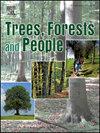Taxonomical enumeration of traditional, socio-economic importance plant of Dharbai
IF 2.7
Q1 FORESTRY
引用次数: 0
Abstract
The grass family, Poaceae, which encompasses over 11,500 species, is considered among the most significant flowering plants globally. The traditional Dharbai grass, Desmostachya bipinnata, is of religious and socio-economic importance, commonly used in Hindu rituals and as a natural disinfectant. However, its resemblance to Chrysopogon zizanioides and Saccharum spontaneum poses challenges in identification. This paper aims to distinguish between these species through a detailed examination of their morphological and anatomical features. Specimens of Chrysopogon zizanioides and Saccharum spontaneum were collected from Thiruppanandal, Kumbakonam district, Tamil Nadu, India. Both morphological and microscopic examinations were conducted using stereomicroscopes and light microscopes to analyze leaf, stem, root, and inflorescence structures. In terms of reproductive features, three anthers and two feathery stigmas are observed, with an oblong-shaped ovary. In anatomical observations of the leaf cross-section, a single-layer epidermis, hypodermis with sclerenchyma cells, and vascular bundles with phloem and xylem are identified. The culm cross-section shows epidermis, sclerenchyma hypodermis, and apith made of parenchyma. The root cross-section displays distinct layers including epidermis, exodermis, and a central core of xylem and phloem. Traditionally, Chrysopogon zizanioides is utilized for various ailments, including kidney stones and respiratory issues, and features in religious customs. These observations and descriptions of Chrysopogon zizanioides are detailed below, Dense, aromatic roots with erect culms 1–2.5 m tall. Leaf blades are linear and stiff, with jagged margins. The inflorescence is an oblong panicle with spikelet pairs. The structure is similar to S. spontaneum but is distinct in certain vascular arrangements and the presence of amyloplasts in pith cells. Morphological and anatomical features can adequately differentiate Desmostachya bipinnata, Chrysopogon zizanioides, and Saccharum spontaneum. While the three share some common traits, there are notable distinctions. For example, C. zizanioides is characterized by a dense aromatic root, whereas S. spontaneum is distinguished by its serrated leaf margins. The distinct characteristics of the traditional plant Desmostachya bipinnata (Dharbai) have been validated through morphological and anatomical evaluation. This confirmation is crucial for preserving its socio-economic significance and uses in traditional practices.
达尔拜传统、重要社会经济植物的分类枚举
禾本科,包含超过11500种,被认为是全球最重要的开花植物之一。传统的Dharbai草Desmostachya bipinnata具有宗教和社会经济重要性,通常用于印度教仪式,并作为天然消毒剂。然而,它与金沙草和天然糖的相似性给鉴定带来了挑战。本文旨在通过对其形态和解剖特征的详细检查来区分这些物种。摘要在印度泰米尔纳德邦Kumbakonam地区的Thiruppanandal地区采集到金沙草(Chrysopogon zizanioides)和天然糖(Saccharum spontanum)标本。利用立体显微镜和光学显微镜对叶、茎、根和花序结构进行了形态学和显微检查。生殖特征:3个花药,2个羽状柱头,子房长圆形。在叶的横切面解剖观察中,可以辨认出单层表皮、含有厚壁组织细胞的下皮层和含有韧皮部和木质部的维管束。茎横切面为表皮、下厚壁组织和由薄壁组织构成的茎。根的横切面显示出明显的层,包括表皮、外表皮和木质部和韧皮部的中央核。传统上,菊花被用来治疗各种疾病,包括肾结石和呼吸问题,以及宗教习俗的特征。这些观察和描述详细如下:根密,芳香,直立茎高1-2.5米。叶片线形和硬,具锯齿状边缘。花序为一长圆形圆锥花序,具小穗对。其结构与自发葡萄球菌相似,但在某些维管排列和髓细胞中淀粉体的存在上是不同的。形态和解剖特征可以充分区分双峰菊、金沙菊和天然糖。虽然这三者有一些共同的特点,但也有显著的区别。例如,C. zizanioides的特征是其致密的芳香根,而S. spontanum的特征是其锯齿状的叶缘。通过形态学和解剖学鉴定,证实了传统植物石竹的独特特征。这一确认对于保存其社会经济意义和在传统做法中的用途至关重要。
本文章由计算机程序翻译,如有差异,请以英文原文为准。
求助全文
约1分钟内获得全文
求助全文
来源期刊

Trees, Forests and People
Economics, Econometrics and Finance-Economics, Econometrics and Finance (miscellaneous)
CiteScore
4.30
自引率
7.40%
发文量
172
审稿时长
56 days
 求助内容:
求助内容: 应助结果提醒方式:
应助结果提醒方式:


